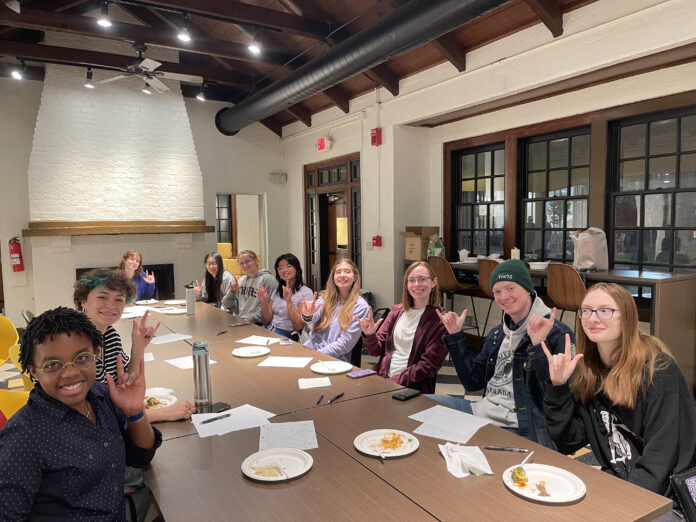American Sign Language is the third most popular language used in the United States, behind Spanish and English. The language has grown in popularity across communities and schools, including the College of William and Mary as awareness is raised about deaf culture and accessibility.
Philip Woodward ’01 J.D ’04 founded the College’s ASL Club in the late 1990s and it has most recently been led by president Ella Briggs ’25. Briggs found a passion for ASL in her senior year of high school and decided to join the club after coming to the College. She joined the executive board and has been president for the past three years, striving to create community and educate people about deaf culture.
“The mission overall is just to learn together both about ASL as a language, to become better speakers at it or start speaking it at all, and then to learn together more about deaf culture and accessibility and how to be more inclusive in the broader world of deaf and disabled people,” Briggs said.
Club meetings are held each week and start with the usual announcements and housekeeping about upcoming events and ideas. Briggs explained that the next portion of the meeting is called “Culture Corner,” which involves learning about different aspects of American Sign Language, like looking at word play in ASL or historical figures. Briggs also highlighted the preparation that goes into these events and activities.
“All the research that I do for the club comes from deaf sources and people within the deaf community,” Briggs said.
During its weekly meetings, the club also organizes language lessons on ASL, teaching members important words and basic greetings. Other vocab based around a theme that members can help come up with is also frequently taught. Briggs explained that the theme is important when learning words, because out of context, it can be harder to find use for them.
Twice a semester, the ASL Club hosts a silent dinner for its members. The group heads to The Daily Grind where free food is provided. As the name suggests, the dinner is silent and members are only allowed to communicate through signing.
“Being in the silent dinner was a very interesting experience to realize how much I rely on oral communication, which should have been obvious, but it really pointed it out and it’s a great way to practice signing,” ASL Club Secretary Bella Strong ’25 said.
Through these group events and activities, a strong community has been formed among the ASL Club members. Member Evan Collier ’24 stumbled upon the club at this semester’s club fair and decided to join on a whim. Since then, he reflected that he has found a welcoming community, enjoys learning ASL and plans on continuing the club in the following semester.
“They’re really cool people,” Collier said. “It’s not something I anticipated joining at all when I got here, but they had a good pitch and I am enjoying my time.”
Not only have connections been made within the club but also with members of the deaf community outside of the College. The organization has gone to off-campus deaf social events and been able to learn about people’s experiences.
“Most people don’t regularly encounter deaf people,” Collier said. “So when you make that initiative to show ‘I want to communicate with you,’ it means something, you know?”
The club has often collaborated with other organizations at the College to educate a broader community on accessibility and to meet new groups of people. Some examples of these include working with Student Assembly to teach a beginner workshop on ASL and talking with sororities and fraternities about DEI initiatives and accessibility.
“I do think it’s really nice that there has been an effort to just get the most basic understanding of what ASL is from other groups, and that has been really nice,” Strong said.
In terms of raising awareness for students at the College, Briggs shared that she has spoken to Student Accessibility Services about the way the College accommodates deaf students, as well as working to get more ASL resources on campus.
“Before last semester, we were the only ASL resource on campus because we don’t have any ASL classes,” Briggs said. “But last semester Swem started a once-a-week class through the library, not for credit, but it only has about 20 spots and it fills up really fast.”
In the future, Briggs said she hopes that the club will have more large-scale events and continue to spread awareness about accessibility. Briggs noted this could include having more guest speakers, as well as trying to reintegrate ASL classes into the course catalog through the modern languages and literatures department.
Strong expressed where she would like to see the club go in the future and how it could be different than it is now. She explained that with more hard of hearing people in the club, especially on the executive board, it would open people up to personal experiences more, whereas now the focus is more on learning the ASL language with second hand sources.
“We always have to get our information secondhand and we have to be very careful,” Strong said. “We don’t want to make wide generalizations about a community that we’re not a part of, but at the same time, we want to raise awareness for certain issues.”
Overall, members of the ASL Club said they are always willing to accept all members no matter the skill level and will continue to spread awareness about accessibility and the cultural diversity of the deaf and hard of hearing community at the College and beyond.
“It’s not as scary as it seems. It is learning a new language, but it’s so fun and it’s so easy to start,” Briggs said. “It’s so fun and it’s so rich in culture and so diverse. There’s so much to learn about it.”

